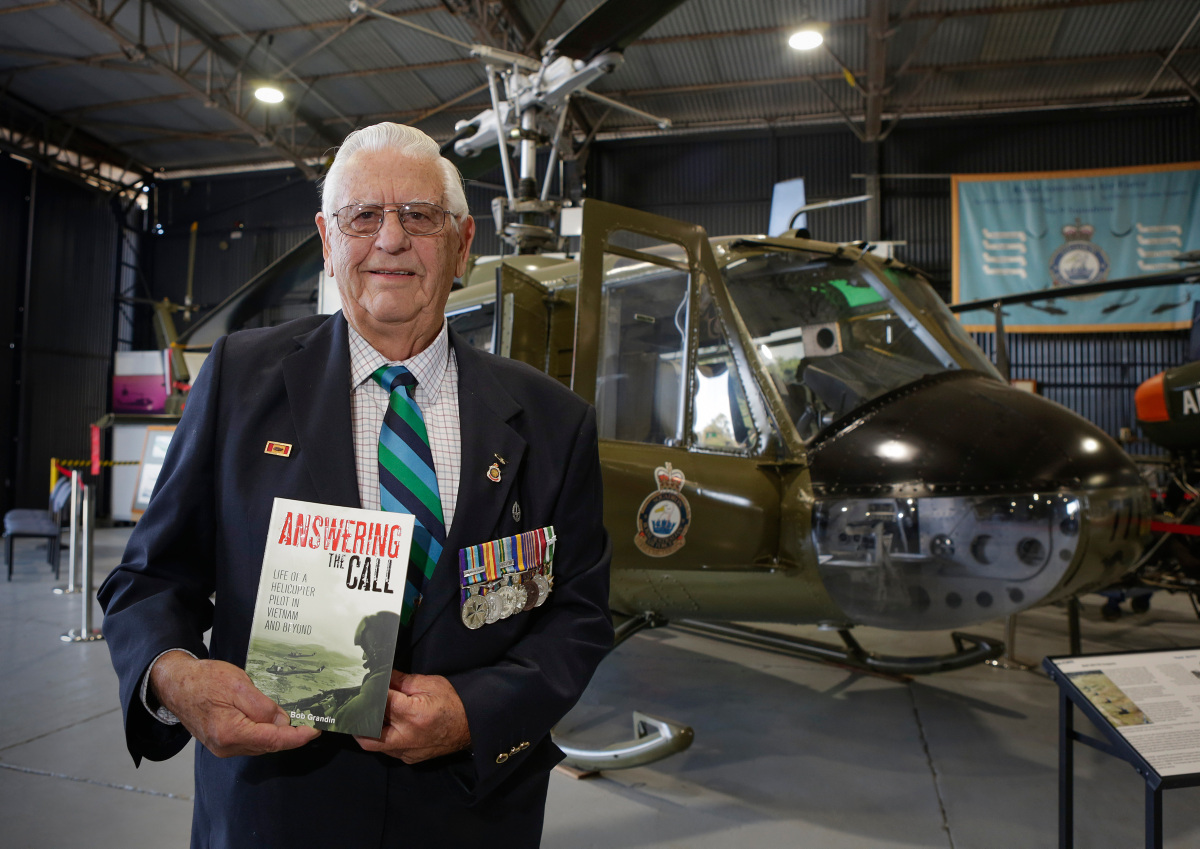What was expected to be another routine day shuttling rations and celebrities around Vietnam turned into a day Dr Bob Grandin would never forget when he found himself flying into a monsoon and bang into the middle of the Battle of Long Tan.
Dr Grandin was a Royal Australian Air Force helicopter pilot stationed in Vietnam.
His new book Answering the Call – the life of a helicopter pilot in Vietnam and beyond was written from the log book he kept while stationed in Nui Dat.
The book is also interwoven with stories of his life after Vietnam, revealing the difficulties he faced back home, the impact of the war on his psyche and relationships, and his struggles with Post-Traumatic Stress Disorder (PTSD).
Dr Grandin launched his book at the RAAF Amberley Aviation Heritage Centre where the Iroquois helicopter he flew in Vietnam is on display.
It’s 53 years this month since the Battle of Long Tan but now, Dr Grandin said, is the time for his story to be told.
“It was a bad time when we returned from Vietnam, but now we have the opportunity to tell these stories so people can understand what they did,” Dr Grandin said.
“I’m just happy to be getting the story out that people have overlooked.”
He is also the editing author of newly released movie Danger Close: The Battle of Long Tan. Dr Grandin said watching the movie really put him back in the helicopter seat.
Flight Lieutenant (Flt Lt) Robert George (Bob) Grandin at the controls of his Iroquois helicopter.
On 18 August 1966, he was the co-pilot on a No 9 Squadron Iroquois helicopter that flew over the enemy to resupply desperate soldiers engaged in battle at the Long Tan rubber plantation.
“I was a co-pilot in a support squadron so the first job of the day was to fly Little Pattie and Col Joye up to Nui Dat for a concert,” Dr Grandin said.
“We thought it was just going to be a routine day.”
But once he landed at the Australian Task Force base he quickly discovered that the day was going to be anything but.
“The artillery started when we arrived and we soon discovered 6RAR had run into a huge enemy force nearby and they were running out of ammo,” he said.
“My skipper, Captain Frank Riley, said that he would take the ammo.”
At that time, it was not a sanctioned mission.
An Iroquois support squad had never done this before.
They wound have to fly into the middle of a battle without any fire support of their own.
Little Pattie performs with Col Joye and the Joy Boys in Nui Dat. During the concert, the Battle of Long Tan commenced in a nearby rubber plantation. Little Pattie was flown out of the danger zone shortly after this photo was taken, however Col Joye and the Joy Boys were unable to be evacuated until the next morning. Image courtesy: Australian War Memorial
“As soon as I walked outside the briefing tent I said ‘what the hell are you doing? This is a suicide mission’,” Dr Grandin said.
“I said ‘how are we going to get back?’
“He said ‘we probably won’t, you don’t have to come’ but of course we did.”
There was a very large tropical storm unleashing when they took off and visibility was so poor the only way they could navigate was by looking through the floor.
“I was looking down between my feet at the tops of the trees,” he said.
“That storm was probably the thing that saved us, they probably didn’t hear us.”
“We found ourselves lost behind the enemy line and we only found our guys when they threw smoke.”
The chopper lowered down but did not land.
After they guided the second chopper into position they rolled on their side and kicked the ammo boxes out.
“We just hovered over the rubber tree and the ammunition rained out on them,” he said.
Dr Grandin believes the actions of the chopper pilots that day saved the lives of the infantry men on the ground.
“If we hadn’t come they were all doomed, the whole time I was terrified,” he said.
“I was just thinking a bullet is going to come in and hit the ammo and we would be blown up.”
No 9 Squadron, RAAF, Iroquois helicopter pilots Flight Lieutenant (Flt Lt) Bruce Ivan Lane, and Flt Lt Robert George (Bob) Grandin (right) at Vietnam. Image courtesy Australian War Memorial
The Battle of Long Tan
On 18 August 1966, D Company, 6th Battalion, The Royal Australian Regiment (6RAR) fought a battle against more than 2 000 North Vietnamese and Viet Cong troops in a rubber plantation near the village of Long Tan.
After fighting in torrential rain for four hours, and almost being overrun, they were supported by accurate artillery fire from the nearby Australian task force base, an ammunition resupply by two Iroquois helicopters from 9 Squadron, RAAF, and the arrival of infantry reinforcements carried by Armoured Personnel Carriers.
Eighteen Australians were killed and twenty-four wounded as a result of this engagement, which became known as the Battle of Long Tan.

